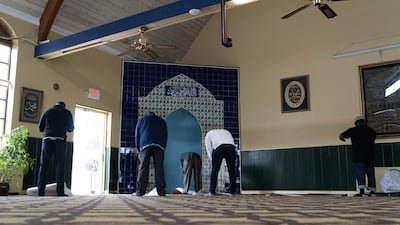Inside the Masjid Muhammad in Washington, Imam Talib Shareef carefully folds his body forward and performs the thuhr, or noon prayer.
Behind him, a handful of worshippers, each one metre apart, follow suit.
Masjid Muhammad had been closed for prayers for more than a year, but it has opened to a limited number of worshippers each day for Ramadan.
“We’re having a soft opening right now, which means we are requiring that people take the public health precautions – cleaning the hands, wearing face masks, distancing – that’s still something we’re going to require,” Imam Shareef said.
The mosque will limit crowds to 20 per cent of its capacity, allowing worshippers to safely keep their distance.
A year after the coronavirus pandemic kept Muslims across the US and around the world away from mosques during Ramadan, this year feels like a small but important step towards normality.
"It makes a huge difference because as a Muslim, the mosque is a sacred place where people have to go and pray and get together and I think share the benefits of Ramadan, helping each other,” said Papa Sey, who attended noon prayers at the mosque.
“So, it’s a huge difference to be able to go this year.”
Across the Potomac River in northern Virginia, the Dar Al Hijrah Mosque, one of the largest in the area, has divided evening prayers into two shifts to prevent overcrowding.
“There are prayers but the numbers are 40 per cent less of what we typically have,” said Saif Rahman, head of public and government affairs at the mosque.
"We are accommodating about 650 people a shift, whereas we would typically have 1,000-plus for the night prayers."
The mosque has installed an ultraviolet filtration system to try to create the safest environment possible.
But Mr Rahman acknowledged that not everyone was ready to return to in-person worship.

“There are still some people who are not comfortable with in-person services yet, just due to the mental health element of this pandemic and how it has affected people,” he said.
Dar Al Hijrah has opened for prayers but it is not completely back to normal.
“The difference for this year is we don’t have our communal breaking of fast, which we do every year," Mr Rahman said.
"We’re simply going to be distributing hot meals to people in need on a nightly basis."
The mosque expects to feed between 600 and 700 people a night.
The major difference between this Ramadan and last has been the remarkable distribution of vaccines in the US, where more than 36 per cent of the population has received at least one dose.
"Almost half of our community has had the vaccine," Imam Shareef told The National.
He spent much of the past year encouraging worshippers to have the vaccine.
“Last Ramadan, we prayed for a vaccine," he said. "There wasn’t one in sight and we prayed for it and now we have a vaccine. So I let them know that this is our prayers being answered.”
Imam Shareef hopes that next year, with even more people vaccinated, his community will be able to gather as they did before the pandemic.











